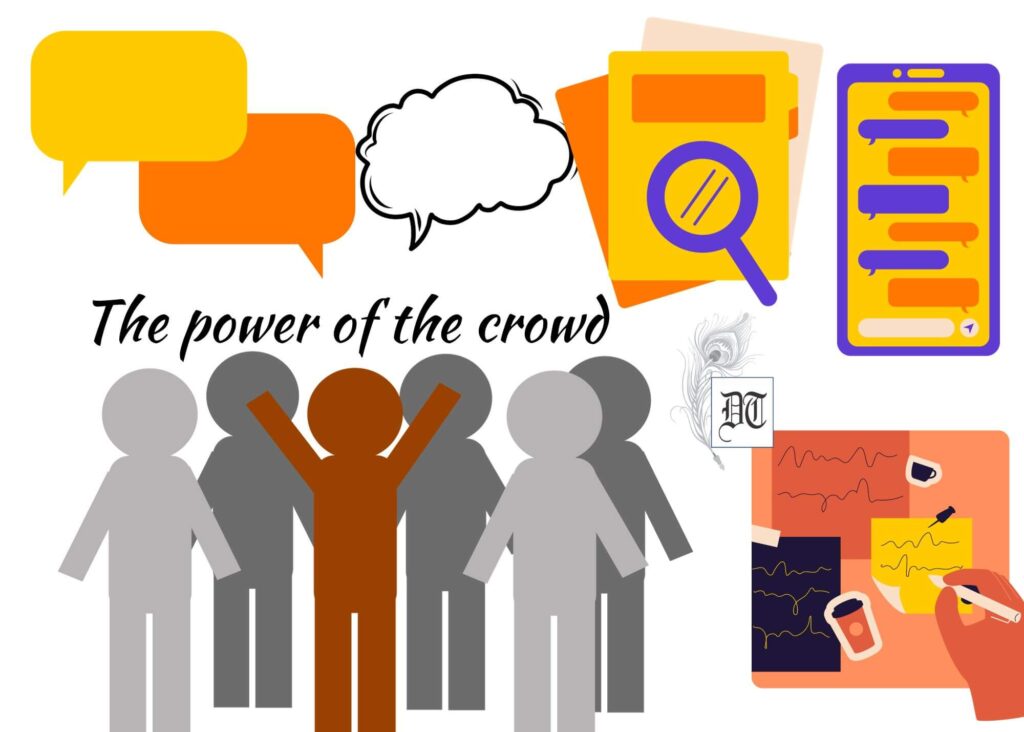Reading Time: 6 minutes
This study, by Arindam, explores the role of user-generated content (UGC) in two parts: real-time news reporting and the potential of crowdsourced verification to improve its credibility, emphasising the need for a balanced approach in digital communication, exclusively for Different Truths.

User-generated content (UGC) has emerged as a crucial element in the realm of news reporting within participatory social journalism, introducing a wealth of diverse perspectives and real-time information. This phenomenon has undeniably transformed the landscape of news dissemination, but its credibility poses a multifaceted scenario, offering both opportunities and challenges.
One prominent opportunity associated with UGC lies in its capacity to provide a platform for an array of diverse voices and perspectives. This inclusivity contributes to a more thorough understanding of events, as Alfred Hermida noted in his study from 2012. Unlike traditional journalism, UGC allows individuals from various backgrounds and experiences to share their viewpoints, enriching the narrative with a mosaic of insights that may not be represented in mainstream media.
However, this diversity inherent in UGC also gives rise to significant challenges, particularly in terms of credibility. As Thurman et al. (2010) argue, the varying levels of accuracy and potential bias among user-generated content necessitate meticulous verification processes. Unlike professionally curated news sources, UGC lacks the inherent editorial oversight that traditional media outlets provide. Consequently, information may range from accurate and insightful to misleading or even deliberately false.
To address these challenges, news organisations have implemented various strategies to enhance the credibility of UGC. Fact-checking initiatives have gained prominence to verify the accuracy of user-generated content before incorporating it into news reports. For a stricter validation process, newsrooms work together to do things like comparing user-generated content (UGC) with official statements, eyewitness accounts and well-known news sources.
Advancements in technology have played a pivotal role in improving the verification of UGC.
Moreover, advancements in technology have played a pivotal role in improving the verification of UGC. Image and video analysis tools, for instance, enable news organisations to assess the authenticity of multimedia content by examining metadata, conducting reverse image searches, and utilising forensic analysis techniques. These technological interventions empower journalists to sift through vast amounts of user-generated content efficiently and effectively, enhancing the overall reliability of the information being disseminated.
Despite these advancements, it is crucial to acknowledge that challenges persist. The rapid pace at which information circulates through social media platforms, often outpacing the verification process, poses an ongoing hurdle for journalists and fact-checkers. Additionally, the prevalence of deepfakes and manipulated media further complicates the task of distinguishing between authentic and fabricated content.
Thus, the integration of user-generated content into news reporting has ushered in a new era of participatory journalism, offering a diverse range of perspectives and real-time information. UGC has both pros and cons. The pros include being open to everyone and helping people understand events better. The cons include varying levels of accuracy and possible bias. User-generated content is becoming more trustworthy as strong verification processes and fact-checking programs, and technological advances are put in place. This makes the news landscape more reliable and informative.
Real-Time Reporting:
Real-Time reporting in the era of UGC represents a significant opportunity and challenge in the realm of information dissemination. The burgeoning use of UGC platforms, such as social media, has transformed the landscape of news reporting, offering unparalleled speed in the dissemination of information. According to Quandt et al. (2016), UGC plays a pivotal role in facilitating real-time reporting. allowing users to share news and updates instantaneously, thereby contributing to the rapid flow of information across the globe.
The opportunity that UGC offers in real-time reporting is particularly obvious in its ability to break news quickly.
The opportunity that UGC offers in real-time reporting is particularly obvious in its ability to break news quickly. Social media platforms like Twitter, Facebook, and Instagram serve as primary conduits for users to share firsthand accounts, images, and videos of unfolding events. This immediacy enables news organisations and individuals to stay abreast of developing situations, providing a dynamic and up-to-the-minute account of events. This expeditious reporting has proven crucial in various contexts, including natural disasters, political upheavals, and other time-sensitive occurrences.
However, the accelerated pace of real-time reporting through UGC also introduces a formidable challenge—the potential compromise of accuracy. Diakopoulos (2016) highlights a concern that arises from the immediacy of UGC, wherein users may forego or inadequately conduct fact-checking procedures before sharing information. The rapid nature of UGC dissemination can lead to the circulation of unverified or misleading content, contributing to the spread of misinformation. This problem has become especially important when false or sensationalised information spreads quickly before it can be fixed, which hurts the trustworthiness of the information ecosystem.
The tension between the opportunity and challenge in real-time reporting through UGC underscores the need for a balanced and informed approach.
The tension between the opportunity and challenge in real-time reporting through UGC underscores the need for a balanced and informed approach. While the speed of information sharing is invaluable in keeping the public informed, the potential pitfalls associated with inaccuracies demand a conscientious and discerning user base. News organizations, social media platforms, and individual users alike must prioritize accuracy over expediency, implementing mechanisms for fact-checking and verification in the fast-paced world of real-time reporting.

To mitigate the challenge posed by the potential compromise of accuracy, various initiatives have been introduced. Social media platforms have implemented fact-checking tools and algorithms to identify and flag potentially misleading content. Additionally, media literacy campaigns aim to educate users about the importance of critically evaluating information before sharing it, fostering a more discerning online community.
Therefore, real-time reporting through UGC presents a dual-edged sword of opportunity and challenge. UGC platforms’ immediate nature makes it possible for information to spread quickly, which contributes to dynamic and current news reporting. However, the inherent risk of compromised accuracy emphasizes the need for vigilant fact-checking and verification processes. By navigating this delicate balance, the information ecosystem can harness the benefits of real-time reporting while mitigating the challenges posed by the potential spread of misinformation.
Crowdsourced Verification for Enhanced Credibility
In the era of digital communication, the proliferation of UGC has become an integral part of online discourse. The rise of social media platforms and online communities has enabled individuals to share information instantaneously. However, this surge in UGC has also given rise to concerns regarding the authenticity and accuracy of the information shared. To address this challenge, researchers and practitioners have explored the potential of crowdsourced verification as a mechanism to enhance the credibility of online content.
Opportunity:
Crowdsourced verification, as conceptualized by Anderson and Domingos (2005), taps into the collective intelligence of online communities to verify the accuracy of user-generated content. This approach leverages the diverse skills and knowledge of a large number of individuals, distributed across the internet, to collaboratively fact-check information. By harnessing the power of the crowd, this method has the potential to improve the reliability of online content, making it more trustworthy for users.
The collaborative nature of crowdsourced verification offers a unique advantage in cross-referencing information and validating claims.
The collaborative nature of crowdsourced verification offers a unique advantage in cross-referencing information and validating claims. Online communities can collectively contribute to the verification process, bringing together individuals with varied expertise and perspectives. This diversity helps in minimizing biases and errors that may arise from relying solely on traditional fact-checking methods.
Furthermore, the process of crowdsourced verification aligns with the principles of transparency and openness. Users participating in the verification process can provide insights into their methodology, sources, and reasoning, allowing for a more nuanced understanding of the credibility assessment. This transparency fosters a sense of trust among community members, reinforcing the reliability of the verified information.
Challenge:
Despite the promising potential of crowdsourced verification, challenges persist in its implementation. One significant concern is the rapid spread of misinformation when effective verification mechanisms are lacking (Zubiaga et al., 2018). In the absence of robust systems to validate information, false or misleading content can circulate quickly, leading to potential harm and public confusion.
The challenge lies in establishing efficient and timely crowdsourced verification processes.
The challenge lies in establishing efficient and timely crowdsourced verification processes. As the volume of online content continues to grow, there is a need for scalable solutions that can handle the vast amount of information circulating on digital platforms. Additionally, ensuring the accuracy and reliability of the verification outcomes is crucial, as unchecked misinformation can undermine the very purpose of the crowdsourced approach.
Finally, crowdsourced verification presents a valuable opportunity to enhance the credibility of user-generated content in online communities. By tapping into the collective intelligence of diverse individuals, this approach has the potential to improve the accuracy and reliability of information shared on digital platforms. However, to fully realize these benefits, it is essential to address the challenges associated with the rapid spread of misinformation and establish robust verification mechanisms. As online communication continues to evolve, leveraging crowdsourced verification can contribute to a more trustworthy and informed digital landscape.
References:
Hermida, A. (2012). Tweets and Truth: Journalism as a discipline of collaborative verification. Journalism Practice, 6(5-6), 659-668.
Thurman, N., et al. (2010). Making the News: The Role of User-Generated Content in the Production of Online News. European Journal of Communication, 25(2), 147–163.
Quandt, T., et al. (2016). Journalism research in times of crisis. Digital Journalism, 4(8), 933-939.
Diakopoulos, N. (2016). Accountability in Algorithmic Decision Making. Communications of the ACM, 59(2), 56-62.
Anderson, C., & Domingos, P. (2005). Mining data streams for clues to interesting changes in a data warehouse. In KDD ’05: Proceedings of the Eleventh ACM SIGKDD International Conference on Knowledge Discovery in Data Mining (pp. 737-742).
Zubiaga, A., Kochkina, E., Liakata, M., Procter, R., & Lukasik, M. (2018). Discourse-aware rumour stance classification in social media using sequential classifiers. Information Processing & Management, 54(2), 273-290
Picture design by Anumita Roy














